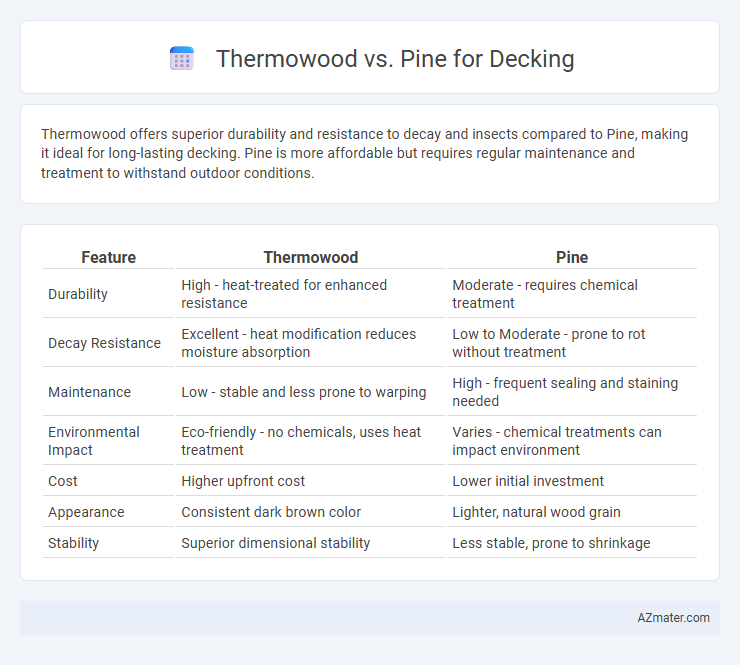Thermowood offers superior durability and resistance to decay and insects compared to Pine, making it ideal for long-lasting decking. Pine is more affordable but requires regular maintenance and treatment to withstand outdoor conditions.
Table of Comparison
| Feature | Thermowood | Pine |
|---|---|---|
| Durability | High - heat-treated for enhanced resistance | Moderate - requires chemical treatment |
| Decay Resistance | Excellent - heat modification reduces moisture absorption | Low to Moderate - prone to rot without treatment |
| Maintenance | Low - stable and less prone to warping | High - frequent sealing and staining needed |
| Environmental Impact | Eco-friendly - no chemicals, uses heat treatment | Varies - chemical treatments can impact environment |
| Cost | Higher upfront cost | Lower initial investment |
| Appearance | Consistent dark brown color | Lighter, natural wood grain |
| Stability | Superior dimensional stability | Less stable, prone to shrinkage |
Introduction to Thermowood and Pine Decking
Thermowood decking is created through a controlled thermal modification process that enhances the wood's durability, stability, and resistance to decay without using chemicals. Pine decking, commonly sourced from species like Southern Yellow Pine, is valued for its affordability, natural strength, and ease of staining or painting. Both materials offer distinct advantages in decking applications, with Thermowood providing longer lifespan and reduced maintenance, while Pine delivers cost-effective versatility.
Composition and Production Processes
Thermowood decking is produced through a controlled thermal modification process where pine wood is heated to temperatures between 160-220degC in a low-oxygen environment, altering its chemical composition by breaking down hemicelluloses and reducing moisture content. This treatment enhances the wood's durability, dimensional stability, and resistance to decay compared to untreated pine, which consists primarily of natural resin and cellulose and is more prone to moisture absorption and weathering. Pine decking undergoes minimal processing beyond drying and planing, making Thermowood a superior option where enhanced structural longevity and resistance to environmental factors are critical.
Durability and Lifespan Comparison
Thermowood decking offers superior durability compared to pine due to its heat-treated process, which enhances resistance to rot, decay, and insect attacks. Pine, being a softerwood, requires chemical treatments to improve its lifespan but generally lasts 5 to 10 years less than thermally modified wood under similar outdoor conditions. Thermowood's enhanced stability and moisture resistance can extend the decking lifespan to 25 years or more, making it a more cost-effective and long-lasting option for outdoor applications.
Resistance to Weather and Environmental Factors
Thermowood decking offers superior resistance to weather and environmental factors compared to untreated pine due to its thermal modification process, which enhances durability and reduces moisture absorption. Pine, while cost-effective, is more prone to swelling, warping, and fungal decay when exposed to constant moisture and UV radiation. The enhanced stability and rot resistance of Thermowood make it a preferred choice for long-lasting outdoor decking in harsh climates.
Maintenance Requirements: Thermowood vs Pine
Thermowood decking requires significantly less maintenance than pine due to its enhanced durability and resistance to rot, fungi, and insects achieved through controlled thermal modification. Unlike pine, which demands regular sealing, staining, or painting to prevent weathering and decay, Thermowood maintains its dimensional stability and color with minimal upkeep, typically needing only occasional cleaning and re-oiling. Choosing Thermowood reduces long-term maintenance costs and effort, making it a superior choice for low-maintenance, sustainable decking solutions.
Aesthetic Differences and Finish Options
Thermowood decking offers a rich, deep brown hue with enhanced texture from its heat treatment, creating a modern and uniform appearance compared to the lighter, more natural look of pine, which often features knots and grain variations for a rustic charm. Pine decks are typically finished with stains or paints that highlight its natural warmth and can be easily customized, while Thermowood's surface responds well to transparent or semi-transparent oil finishes that preserve its color and increase durability. The choice between Thermowood and pine for decking aesthetics hinges on the desired style, with Thermowood providing a sleek, stable finish and pine offering versatile finishing options that age with character.
Sustainability and Environmental Impact
Thermowood decking offers enhanced sustainability through its extended durability and resistance to decay, reducing the need for chemical treatments and frequent replacement compared to untreated pine. Pine decking, while more readily renewable and widely available, often requires significant chemical preservatives to withstand weathering, which can negatively impact the environment. Choosing Thermowood decreases overall environmental impact by maximizing the lifespan of wood resources and minimizing chemical use, supporting eco-friendly decking solutions.
Installation: Ease and Best Practices
Thermowood decking offers easier installation due to its enhanced dimensional stability, reducing the risk of warping or shrinking during fastening compared to traditional pine. Best practices for Thermowood include pre-drilling holes to prevent splitting and using corrosion-resistant screws to maintain longevity. Pine decking requires thorough sealing before installation to protect against moisture, and installers should allow for natural wood expansion by spacing boards properly to avoid buckling.
Cost Comparison: Initial and Long-term
Thermowood decking typically costs 20-30% more upfront than pine due to its specialized heat treatment process enhancing durability and resistance. Pine offers a lower initial investment but demands frequent maintenance and replacement, increasing lifetime expenses. Over time, Thermowood presents better value through reduced upkeep and longer lifespan, balancing its higher initial price with cost savings in maintenance and durability.
Summary: Choosing the Right Decking Material
Thermowood offers enhanced durability, resistance to decay, and dimensional stability due to its heat treatment process, making it ideal for long-lasting decking in varying climates. Pine, while more affordable and widely available, requires regular maintenance and treatment to prevent moisture damage and insect infestation. Selecting between Thermowood and Pine depends on budget constraints, desired longevity, and maintenance commitment for the decking project.

Infographic: Thermowood vs Pine for Decking
 azmater.com
azmater.com